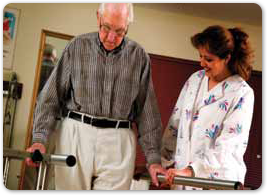
Recently, experts have been paying more attention to how physical therapy can help those with Parkinson’s disease. This degenerative neurological disease is usually treated with medication, but new studies suggest that certain types of therapeutic exercise can make significant improvements in the daily lives of those living with Parkinson’s disease. A 2012 study published in BMJ (formerly British Medical Journal) showed that, in the Parkinson’s population, gait (or walking) speed, balance and level of disability were all positively affected by physical therapy.
What can Parkinson’s patients expect from physical therapy? Skilled therapists will design a program tailored to address the specific problems common in those with this disease. Since Parkinson’s disease can wreak havoc on balance and fluidity of movement, the focus will be on exercises that address these issues. There is some quality evidence that “random practice exercise,” in which you are required to change speed, direction or activity at random intervals, can be especially beneficial to those with Parkinson’s disease. Aerobic exercise that encourages good biomechanics is also recommended.
Since Parkinson’s disease suffers often experience balance problems, muscle weakness, and pain and stiffness in their joints, we will focus on increasing movement through “compensatory treatments” to help you compensate for the physical impact of Parkinson’s disease. Static, repetitive exercise, like walking on a treadmill or stationary biking, are not appropriate for patients with Parkinson’s disease, and weight training can be dangerous due to the high risk of tremors or sudden muscle weakness. We may design an unorthodox program that utilizes dance, ping-pong and skipping along to music. Even Nintendo Wii games, such as tennis, bowling and boxing, improve coordination, reflexes, balance and other movement-related skills as part of an overall therapeutic plan.
Beyond the obvious mind-body connection, activities that require concentration or learning new skills are imperative for those living with neurological conditions, so we may find ways to incorporate cognitive training into your therapy, as well. As an added advantage, physical activity reduces depression, a common side effect of degenerative diseases.
If you or someone you know has Parkinson’s disease, make an appointment with us to begin addressing this condition. While physical therapy cannot cure Parkinson’s disease, it can help those afflicted with this condition live happier, healthier and more independent lives.









